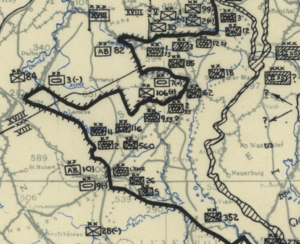Scroll of Honor – Charles Alex Brown
Blunting the Bulge
Written by: Kelly Durham
Charles Alex Brown of Starr spent two years on the Clemson campus. An agriculture major, Brown arrived in 1938 as a member of the Class of 1942. He was a member of the Animal Husbandry Club and was assigned to H Company, 2nd Battalion, 2nd Regiment of the Cadet Brigade. Brown left Clemson after his sophomore year and took a job with C. M. Best Construction Company. When he  entered the Army in 1941, the service took note of his work experience and classified him as a construction foreman. He was assigned to the 33rd Engineer Battalion of the 7th Armored Division.
entered the Army in 1941, the service took note of his work experience and classified him as a construction foreman. He was assigned to the 33rd Engineer Battalion of the 7th Armored Division.
The 7th Armored Division was formed in March 1942 as America ramped up for the war it had been trying to avoid. The division trained at Camp Coxcomb, California and arrived in England in June 1944. The roles of combat engineers in an armored division were varied. The main task of Brown and his battalion would have been to facilitate the movement of their division. This would have involved erecting tactical bridges, clearing enemy minefields, breaching trenches and other obstacles. Engineers were also trained as infantrymen and tactical circumstances would often dictate that they fight alongside their frontline comrades.
The 7th Armored spent little time in England. On August 13 and 14, 1944, it landed on Omaha and Utah Beaches in France and was assigned to General George Patton’s Third Army. The division participated in the offensive on Chartres which fell on August 18. It crossed the Seine River on August 24, no doubt under the watchful eyes of Brown and his fellow engineers. The division pushed on to liberate World War I battlegrounds Château-Thierry and then Verdun on August 31. After a brief halt for maintenance, rest, and refueling, the division resumed the offensive on September 6. It made several attempts to cross the Moselle River northwest of Metz, but the deep river valley was unsuitable for tanks. By linking up with elements of the 5th Infantry Division, the 7th finally was able to cross the river on September 15.
On September 25, the division was transferred to General William Simpson’s Ninth Army as part of the ground support forces for the Airborne Market-Garden offensive into the Netherlands. The division marched north to protect the operation’s east flank from German counterattacks.
In early November, the division was moved into a rest area in order to receive and train replacements for the many men who had fallen in France and the Netherlands. By the end of the month, the division had moved to positions straddling the Dutch-German

The December 22, 1944 situation map shows the 7th Armored Division’s success in blunting the German offensive that came to be known as the Battle of the Bulge.
Library of Congress
border. Part of the division was attached to the neighboring 84th Infantry Division on what was thought to be a relatively quiet sector of the front.
When the Germans launched their surprise Ardennes offensive in mid-December, the 7th Armored Division was transferred to General Courtney Hodges’ First Army and, along with the 106th Infantry Division, ordered to hold St. Vith, Belgium, a critical road and rail center the Germans needed to capture in order to sustain their offensive. The German plan called for the capture of St. Vith by 1800 hours on December 17. Over the course of a snowy, frigid week, the 7th Armored absorbed much of the weight of the German offensive, blunting its progress, and wrecking its precarious timetable. Sergeant Brown was killed near Neundorf during vicious winter combat on December 22. The weakened division was forced to withdraw the following day. By Christmas Eve, the Germans had reached the limits of their supplies, spelling the end of their final offensive.
The 7th Armored Division would recapture St. Vith from the depleted Germans in January 1945. Brown’s body was recovered and buried at Henri-Chapelle American Military Cemetery.
Charles Alex Brown was awarded the Purple Heart. He was survived by his wife, the former Nell Acker of Anderson, his parents, five sisters, and two brothers, one of whom was fighting in Patton’s Third Army and the other who was recovering from wounds in England.
For more information about Sergeant Charles Alex Brown see: 
https://soh.alumni.clemson.edu/scroll/charles-alex-brown/
For additional information about Clemson University’s Scroll of Honor visit:
https://soh.alumni.clemson.edu/
